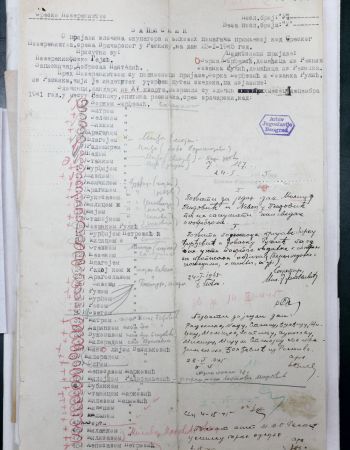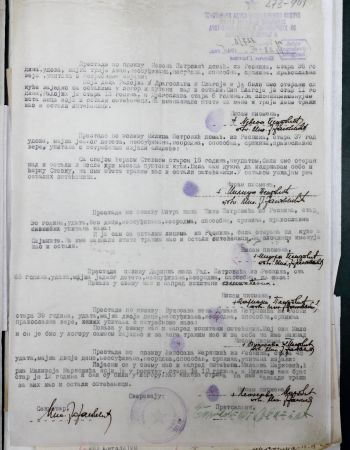Resnik
The white zones on the maps of the pre-war period and on the war-time city plans are spreading over today's peripheral settlements to the east and south of the city. From the depositions of the war damage commission, one can see that the raids of the collaborationist police were also conducted in these, at the time rural communities. Also, in many of them, the German army had found convenient locations for executions of hostages. Locations of such mass shootings are in Rakovica, between the Rakovica monastery and Resnik, the historically incompletely processed location of Bubanj Potok, and the large killing site, a memorial park today - Jajinci. At the similar distance from the then-active camps "Banjica" and "Topovske šupe" were the locations at Jabučki rit and Ledine. The farthest site was at Deliblato. In the vicinity of most of these locations, one can find Roma settlements even today.

A section of Belgrade situational city plan from 1937, Military Geographic Institute, (VGI), Belgrade. Resnik and other suburban villages were not mapped.
The records and the lists
Left: The list of reports on the war damage and the example list of the group statement of the Roma residents of Resnik. The war damage reports for Resnik are kept for 51 people. The records of statements do not contain the addresses from which the Roma were driven off or taken to camps, as they also do not have the addresses of relatives or neighbors who gave the statements to the commission. At the time, Resnik was a village, much like other present-day suburbs like Bele Vode, Makiš, Žarkovo, Mali Mokri Lug... Often there would be no streets or their names, but the collaborationist police knew where to find the Roma for forced labor, hostages, women, and children. It wasn't likely that these were the migratory Roma (čergari) either. Most Roma in the outlying villages was in agriculture just like the majority population. Also, most were released from the camp at Sajmište and have survived the war.
War damages reports for Resnik
| ime | prezime | godište | zanimanje | datum odvođenja | adresa odvodjenja | grad | logor | prijavu podneo | srodstvo | adresa | arh. br. | kratak opis | |||
|---|---|---|---|---|---|---|---|---|---|---|---|---|---|---|---|
| 1 | Milan | Marković | nema | dete | jesen 1941. | Resnik | Beograd | Sajmište | Stanica Marković | majka | Resnik | AJ 273-963 | pušteni kad i ostali | ||
| 2 | Zora | Marković | nema | dete | jesen 1941. | Resnik | Beograd | Sajmište | Stanica Marković | majka | Resnik | AJ 273-963 | pušteni kad i ostali | ||
| 3 | Natalija | Petrović | 40 god | domaćica | jesen 1941. | Resnik | Beograd | Sajmište | Natalija Petrović | lično | Resnik | AJ 273-963 | pušteni kad i ostali | ||
| 4 | Leposava | Petrović | nema | dete | jesen 1941. | Resnik | Beograd | Sajmište | Natalija Petrović | majka | Resnik | AJ 273-963 | pušteni kad i ostali | ||
| 5 | Radoje | Petrović | nema | dete | jesen 1941. | Resnik | Beograd | Sajmište | Natalija Petrović | majka | Resnik | AJ 273-963 | pušteni kad i ostali | ||
| 6 | Aleksandar | Petrović | nema | dete | jesen 1941. | Resnik | Beograd | Sajmište | Natalija Petrović | majka | Resnik | AJ 273-963 | pušteni kad i ostali | ||
| 7 | Rosanda | Petrović | nema | nema | jesen 1941. | Resnik | Beograd | Sajmište | Natalija Petrović | tetka | Resnik | AJ 273-963 | pušteni kad i ostali | ||
| 8 | Živko | Petrović | nema | dete | jesen 1941. | Resnik | Beograd | Sajmište | Natalija Petrović | tetka | Resnik | AJ 273-963 | pušteni kad i ostali | ||
| 9 | Ruža | Petrović | nema | dete | jesen 1941. | Resnik | Beograd | Sajmište | Natalija Petrović | tetka | Resnik | AJ 273-963 | pušteni kad i ostali | ||
| 10 | Đurđa | Petrović | nema | dete | jesen 1941. | Resnik | Beograd | Sajmište | Natalija Petrović | tetka | Resnik | AJ 273-963 | pušteni kad i ostali | ||
Resnik, temporary settlements 2012-2018
In 2018, Belgrade suburbs such as Resnik are the site of the settlement of the economically endangered Roma dislocated by newer conflicts, primarily the war in Kosovo of 1998-1999, and also the dislocation of the population into container-settlements by the Belgrade municipal authorities and welfare services. Resnik is the location of two such settlements - the original one, from 2012, abandoned by its population leaving and being provided permanent housing, and a newer one, built in 2014, and populated mainly by Roma refugees from Bujanovac. The construction of the first project in 2012 wat to house the forced eviction of the Belville informal settlement. It was met with violent protests of local ethnic majority population organized by neo-nazi football fan groups. The settlement for the Roma was attacked, 20 police were injured, and a series of attacks on Roma children on bus stops followed. The settlement had to be placed under permanent police protection. Present-day "temporary settlement" in Kijevo, just next to Resnik, is not under special police protection.
Deportation, Belville, 2012.
The growth of the infrastructure and real-estate markets has among other things, endangered the traditional relations between the city and state on one side, and its most precarious populations - Roma refugees from Kosovo, and migrants from south Serbian municipalities with predominantly Albanian population on the other. On several occasions, municipal authorities have temporarily or permanently dispersed the informal settlements for sports competitions (University games 2009), public infrastructure works (Gazelle bridge 2009, Ada bridge extension, 2012). Part of the residents was "rendered back to the municipalities where they came from", and others were dislocated into the temporary settlements such as Makiš, Lipovička šuma, and Resnik. Most of these settlements were abandoned by the people, mainly because of the impossibility of providing income and transport to the city. A minority among them were transferred to the permanent accommodation in 2013 and 2014, in the suburb of Kamendin, which also resulted in violence against Roma and demonstrations by the local population.
Location Resnik-Kijevo
Living conditions in temporary housing, 2014
From the article of the portal Uperiprstom:
Before journalists can visit some of the newly formed settlements, it is necessary to announce it to the Secretariat for Social Protection, as was explained in the Secretariat, such practices have been introduced at the request of families who do not want any entry into the settlement they live in. In this part of Kijevo there are 39 families, - over 150 people. Each family of up to five members has one mobile housing unit (container) of 12 square meters, a family of six members or more having two containers. The city of Belgrade helped with the purchase of furniture. - The Social Security Secretariat covers all housing costs in newly formed settlements: electricity (electricity accounts for 8,000 dinars per day, i.e. 12,000 dinars per winter, per family), watering, grassing, repair, regular cleaning of settlements and the environment, which includes disinfection, disinsection and deratization, sterilization of animals in the settlement, treatment of diseased animals, etc. In each newly formed village, so-called "social center" mainly serving as a classroom - for additional classes for children, adult education, workshops, education, etc. The Social Center is equipped with libraries, books, computers, benches and chairs. Meetings of the inhabitants of the settlement are held there, and the family can also use it for celebrations of birthdays, slavas (saints), weddings and other social events. - as they say from the Secretariat for Social Protection. Link >
Contact: Center for Holocaust Research and Education - CHRE, tel: +38163247856, e-mail: cieh1chre@gmail.com web: www.cieh-chre.org
* All parts of this website and project are the intellectual property of their authors, partner organizations and companies whose software and licenses and are used on the website, and as such enjoy the legal protection, so no third party can use them without the explicit permission of the authors. (This relates in particular to the concepts, methods and structural elements of the website, map, exhibitions, texts, and visual materials, but is not limited to, and does not exclude other derivatives and authors rights associated with them.) The use of the publication is governed by the Creative Commons license stated on the publication which is free to download.









